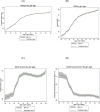Growth dynamics among adolescent girls in Bangladesh: Evidence from nationally representative data spanning 2011-2014
- PMID: 34324581
- PMCID: PMC8321121
- DOI: 10.1371/journal.pone.0255273
Growth dynamics among adolescent girls in Bangladesh: Evidence from nationally representative data spanning 2011-2014
Abstract
Background: Adolescence is the last opportunity to reverse any growth faltering accumulated from fetal life through childhood and it is considered a crucial period to optimize human development. In Bangladesh, a growing double burden of underweight and obesity in adolescents is recognized, yet limited data exists on how, when, and where to intervene. This study assesses the dynamics of growth among adolescent girls in Bangladesh, providing insight about critical junctures where faltering occurs and where immediate interventions are warranted.
Methods: We pooled data from Bangladesh's Food Security and Nutrition Surveillance Project collected between 2011 and 2014 to document the age dynamics of weight and linear growth. 20,572 adolescent girls were measured for height and 19,345 for weight. We constructed growth curves for height, weight, stunting, and underweight. We also stratified growth dynamics by wealth quintile to assess socioeconomic inequities in adolescent trajectories.
Results: Height-for-age z-score (HAZ) in Bangladeshi girls deteriorates throughout adolescence and especially during the early years. Mean HAZ decreases by 0.20 standard deviations (sd) per year in early adolescence (10-14 years) vs 0.06 sd/year during late adolescence (15-19 years), while stunting increases by 16 percentage points (pp) vs 6.7 pp, respectively. Conversely, BMI-for-age z-score (BAZ) increases by 0.13 sd/year in early adolescence vs 0.02 sd/year in late adolescence, and underweight decreases by 12.8 pp vs 3.2 pp. Adolescent girls in all socioeconomic groups show a similar pattern of HAZ and BAZ dynamics, but the curve for the richest quintile stays above that of the poorest across all ages.
Conclusions: Trends and levels of stunting and underweight among adolescent girls in Bangladesh are worrisome, suggesting substantial linear growth faltering in early adolescence, with improving weight-for-age occurring only as linear growth slows and stops. Given the rising burden of non-communicable diseases (NCDs) in Bangladesh and emerging evidence of the link between stunting and later chronic diseases, greater attention to adolescent growth and development is needed. Our findings suggest that, to address stunting, interventions in early adolescence would have the greatest benefits. School-based interventions could be a way to target this population.
Conflict of interest statement
This project received funding from a commercial source, The World Bank Group Bangladesh, to analyze existing surveillance data collected by the BRAC James P. Grant School of Public Health as part of a large project supported by the European Union. This does not alter our adherence to PLOS ONE policies on sharing data and materials.
Figures




References
-
- Martorell R, Khan LK, Schroeder DG. Reversibility of stunting: epidemiological findings in children from developing countries. Eur J Clin Nutr. 1994. Feb;48 Suppl 1:S45–57. - PubMed
-
- Golden MH. Is complete catch-up possible for stunted malnourished children? Eur J Clin Nutr. 1994. Feb;48 Suppl 1:S58–70; discussion S71. - PubMed
MeSH terms
LinkOut - more resources
Full Text Sources
Medical
Miscellaneous

